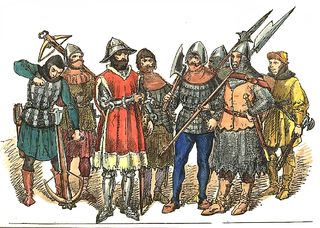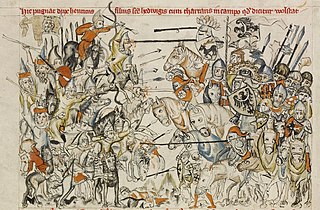
The Battle of Świecino also called the Battle of Żarnowiec or in German Die Schlacht bei Schwetz, took place on September 17, 1462 during the Thirteen Years' War. The Polish forces, commanded by Piotr Dunin and consisting of some 2,000 mercenaries and Poles, decisively defeated the 2,700-man army of the Teutonic Knights, commanded by Fritz Raweneck and Commander of the Order Kaspar Nostitz (Nostyc). Auxiliary forces sent by Duke Eric II of Pomerania, temporary ally of the Teutonic Knights, did not enter the battle.

The charge at Krojanty, battle of Krojanty, the riding of Krojanty or skirmish of Krojanty was a Polish cavalry charge on the evening of 1 September 1939, the first day of the Second World War, near the Pomeranian village of Krojanty. It occurred at the start of the invasion of Poland and was part of the larger Battle of Tuchola Forest. Polish soldiers advanced east along the railway to a railroad crossroads 7 kilometres (4.3 mi) from the town of Chojnice, where elements of the Polish cavalry charged and dispersed a German infantry battalion. Machine gun fire from German armoured cars that appeared from a nearby forest forced the Poles to retreat. However, the attack delayed the German advance, allowing the Polish 1st Rifle Battalion and Czersk Operational Group to withdraw safely.

Chojnice is a town in northern Poland with 38,789 inhabitants, as of June 2023, near the Tuchola Forest. It is the capital of the Chojnice County in the Pomeranian Voivodeship.

The Battle of Legnica, also known as the Battle of Liegnitz or Battle of Wahlstatt, was a battle between the Mongol Empire and combined European forces that took place at the village of Legnickie Pole (Wahlstatt), approximately 10 kilometres (6 mi) southeast of the city of Legnica in the Duchy of Silesia on 9 April 1241.

Stębark, originally Tannenberg, is a village in the administrative district of Gmina Grunwald, within Ostróda County, Warmian-Masurian Voivodeship, in northern Poland. The village is chiefly known for two historic battles which took place there or nearby: the 1410 Battle of Grunwald and the (Second) Battle of Tannenberg in World War I.

The Battle of Płowce took place on 27 September 1331 between the Kingdom of Poland and the Teutonic Order.

The Polish–Lithuanian–Teutonic War, also known as the Great War, occurred between 1409 and 1411 between the Teutonic Knights and the allied Kingdom of Poland and Grand Duchy of Lithuania. Inspired by the local Samogitian uprising, the war began with a Teutonic invasion of Poland in August 1409. As neither side was ready for a full-scale war, Wenceslaus IV of Bohemia brokered a nine-month truce.

The siege of Marienburg was an unsuccessful two-month siege of the castle in Marienburg (Malbork), the capital of the monastic state of the Teutonic Knights. The joint Polish and Lithuanian forces, under command of King Władysław II Jagiełło and Grand Duke Vytautas, besieged the castle between 26 July and 19 September 1410 in a bid of complete conquest of Prussia after the great victory in the Battle of Grunwald (Tannenberg). However, the castle withstood the siege and the Knights conceded only to minor territorial losses in the Peace of Thorn (1411). Marienburg defender Heinrich von Plauen is credited as the savior of the Knights from complete annihilation.
The Polish–Teutonic War of 1519–1521 was fought between the Kingdom of Poland and the Teutonic Knights, ending with the Compromise of Thorn in April 1521. Four years later, under the Treaty of Kraków, part of the Catholic Monastic State of the Teutonic Order became secularized as the Duchy of Prussia. The reigning Grand Master Albert of Hohenzollern-Brandenburg-Ansbach became the first Duke of Prussia by paying the Prussian Homage as vassal to his uncle, Polish king Sigismund I the Old.

Polish–Teutonic Wars refer to a series of conflicts that took place between the Kingdom of Poland and the Teutonic Order, a medieval German military order with roots in the Baltic region. These wars occurred primarily during the 14th and 15th centuries and were characterized by territorial disputes, political maneuvering, and religious differences.

The Battle of Chojnice was a surprise nighttime attack followed by a run-and-chase battle during The Deluge.
The Battle of Chojnice occurred during the 1939 German invasion of Poland on the first day of the hostilities, 1 September. A detached unit from the Polish army Chojnice Detached Group under Colonel Kazimierz Tadeusz Majewski, part of the Czersk Operational Group under Stanisław Grzmot-Skotnicki, was assigned the task of defending the city of Chojnice, a major regional communications center, against the advancing German 20th Motorized Infantry Division in order to protect the southern flank of Army Pomorze.
Rudolf of Żagań was a Duke of Żagań-Przewóz since 1439, from 1449 Duke of Żagań.

The Thirteen Years' War, also called the War of the Cities, was a conflict fought in 1454–1466 between the Crown of the Kingdom of Poland and the Teutonic Order.

Warfare in Medieval Poland covers the military history of Poland during the Piast and Jagiellon dynasties.

The Battle of Grunwald, Battle of Žalgiris, or First Battle of Tannenberg, was fought on 15 July 1410 during the Polish–Lithuanian–Teutonic War. The alliance of the Crown of the Kingdom of Poland and the Grand Duchy of Lithuania, led respectively by King Władysław II Jagiełło (Jogaila), and Grand Duke Vytautas, decisively defeated the German Teutonic Order, led by Grand Master Ulrich von Jungingen. Most of the Teutonic Order's leadership were killed or taken prisoner.
Bernard Szumborski was a Moravian knight and a mercenary. Szumborski was hired by the Teutonic Knights during the Battle of Chojnice, and was sent with 15,000 men to relieve the besieged city of Chojnice. King Casimir IV of Poland sent cavalry attacks to the rear of the Teutonic lines and Szumborski was captured. However, Teutonic knights rallied up and caused panic. Szumborski managed to escape and organized the pursuit of the fleeing Polish army. On October 24, 1457, together with 2000 mercenaries, Szumborski captured Chełmno (Kulm), and killed its mayor, Michal Segemund, claiming that he was a traitor. His forces captured other towns of Pomerelia and Chełmno Land, and on March 21, 1458, Szumborski with his army approached Toruń (Thorn), burning its suburbs, but failing to capture the heavily fortified city. On September 19, 1460, Szumborski captured the town of Golub-Dobrzyń, but Polish garrison of its castle, commanded by Andrzej Puszkarz, managed to hold it. In August 1466, Szymborski, as envoy of the Teutonic Knights, was sent to Bydgoszcz, to negotiate with King Casimir IV and his envoys, Jan Długosz and Jan Sapienski. The negotiations ended on October 19, 1466, when the Second Peace of Thorn was signed. Szymborski, regarded as a very cruel man, died on January 7, 1470. As Jan Długosz recorded, he was poisoned by a female resident of Chełmno.
Siege of Marienburg occurred during the Thirteen Years' War between the Teutonic Knights and the Kingdom of Poland. Marienburg was the capital of the state of the Teutonic Order, in particular, the residence of the Grand Master of the order. An alliance of Prussians and Poles besieged the city beginning 27 February 1454 with mercenaries from Danzig, and the necessary artillery.

Malbork treaty was signed on 9 October 1454, in the fortress of Marienburg (Malbork). It was between the authorities of the Teutonic Order, represented by the Grand Master Ludwig von Erlichshausen, and the commanders (rittmasters) of the mercenary troops fighting on behalf of the Order in the Thirteen Years' War, represented by Bernard von Zinnenberg. In exchange for obtaining a guarantee with the right to sell the most important Prussian strongholds still under the Order's control for unpaid military compensation, the mercenaries agreed to continue military operations on behalf of the Order until 19 February 1455, despite not receiving the agreed payment. This enabled the Teutonic Order to repel the Polish offensive on Malbork in January 1455, recapture Königsberg (Kaliningrad) along with Lower Prussia and Samland from the Prussian Confederation, and regain control of several fortresses from them.

The Battle for Kneiphof was the culmination of the struggle for control over the port district of Kaliningrad, Kneiphof, lasting from April 13 to July 14, 1455, during the Thirteen Years' War (1454–1466), ending with a decisive victory for the Teutonic Order.













